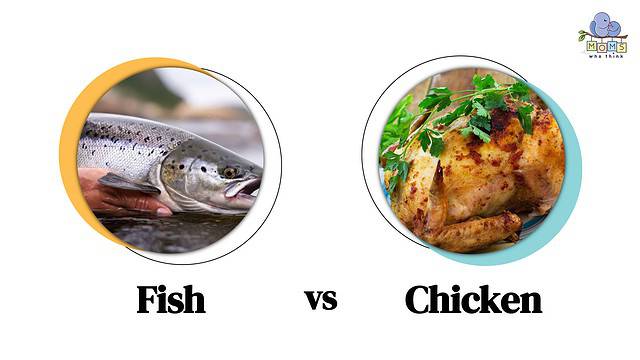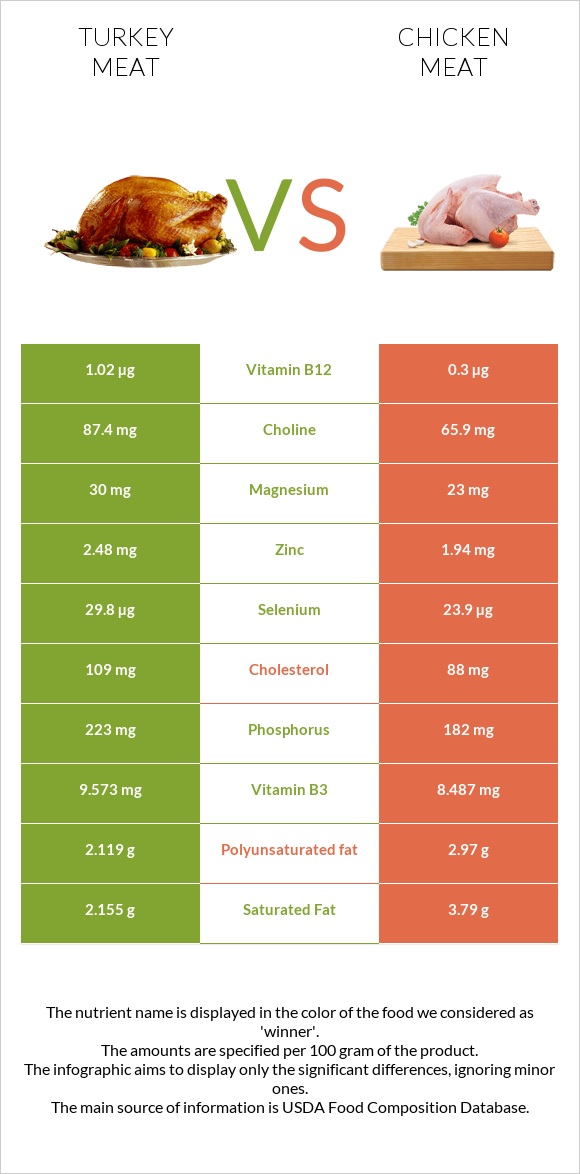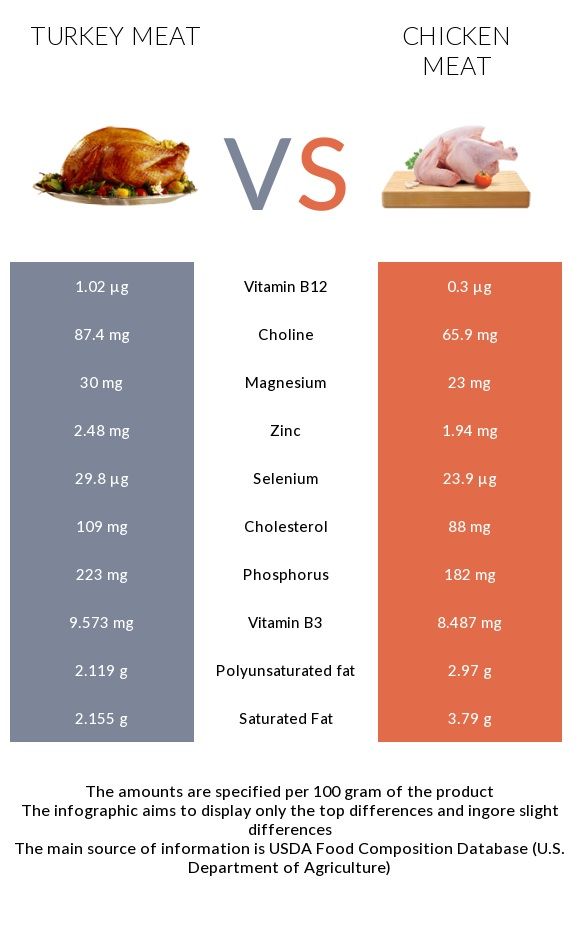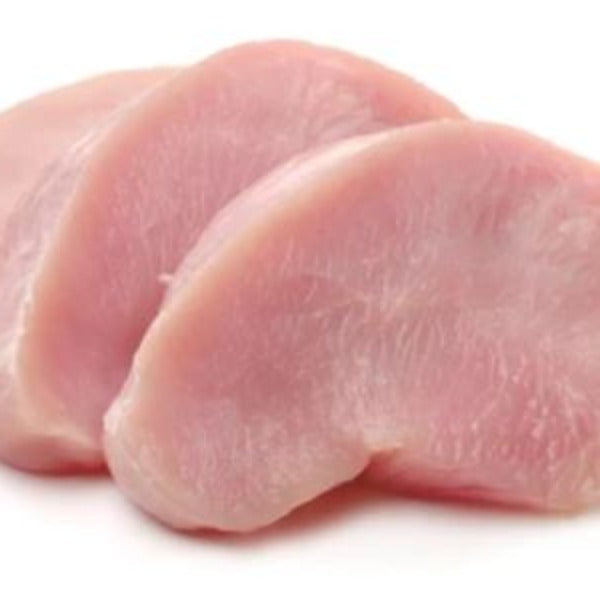Introduction

Poultry is a versatile and popular food option that can be enjoyed in various ways. Chicken and turkey breast are two commonly consumed cuts of poultry that offer numerous health benefits. These lean meats are low in fat and packed with essential nutrients, making them an excellent choice for individuals seeking a nutritious diet. In this article, we will compare the nutritional profiles, taste, texture, and cooking methods of chicken and turkey breast. By understanding the differences and similarities between these two cuts, you can make an informed decision about which poultry option best suits your dietary needs and preferences.
Benefits Of Including Poultry In Your Diet
Including poultry in your diet can offer several benefits. Poultry, such as chicken and turkey breast, is a great source of lean protein, which is essential for muscle growth and repair. It is also low in saturated fat, making it a healthier choice compared to fatty meats. Poultry is rich in vitamins and minerals, including vitamin B6, vitamin B12, zinc, and iron, which are essential for optimal body function. Additionally, poultry is versatile and can be cooked in various ways, allowing for a wide range of delicious and nutritious meal options.
Overview Of Chicken And Turkey Breast Cuts
Chicken and turkey breast cuts are popular choices when it comes to poultry. Chicken breast is typically boneless and skinless, making it lean and versatile. It is known for its mild flavor and tender texture. On the other hand, turkey breast is also lean and can be found with or without the bone. It has a slightly stronger flavor compared to chicken and a firm texture. Both cuts can be used in a variety of recipes, from grilling and roasting to stir-frying and salads. Ultimately, the choice between chicken and turkey breast cuts depends on personal preference and desired cooking method.
Chicken Breast

Chicken breast is a popular choice when it comes to poultry cuts. It is known for its lean and versatile nature. Chicken breast is typically boneless and skinless, making it a healthier option compared to other cuts. It is low in calories and fat, making it an excellent choice for those watching their weight. Chicken breast is also packed with protein, which is essential for muscle growth and repair. With its mild flavor and tender texture, chicken breast can be used in various recipes, from grilling and roasting to stir-frying and salads. Whether you’re looking for a nutritious meal or a tasty addition to your dish, chicken breast is a reliable option.
Nutritional Profile And Health Benefits Of Chicken Breast
Chicken breast is a highly nutritious cut of poultry. It is low in calories and fat, making it an ideal choice for those looking to maintain a healthy weight. A serving of chicken breast provides a good amount of high-quality protein, essential for muscle growth and repair. It is also a rich source of vitamins and minerals, including vitamin B6, which supports brain function, and niacin, which promotes healthy skin and digestion. Additionally, chicken breast is low in sodium and cholesterol, making it a heart-healthy option. Consuming chicken breast regularly can contribute to a well-balanced and nutritious diet.
Different Cooking Methods For Chicken Breast
There are various cooking methods to prepare chicken breast, each offering a unique flavor and texture. Popular options include:
- Grilling: Grilling chicken breast over an open flame adds a smoky flavor and creates attractive grill marks.
- Baking: Baking chicken breast in the oven results in a juicy and tender texture. It can be seasoned with herbs and spices for added flavor.
- Sautéing: Sautéing chicken breast in a skillet with a small amount of oil or butter quickly cooks it to a crispy brown exterior.
- Poaching: Poaching chicken breast in simmering water or broth helps retain its moisture and produces a delicate and soft texture.
- Stir-frying: Stir-frying chicken breast with vegetables in a hot pan creates a quick and flavorful meal option.
Remember to cook chicken breast thoroughly to ensure it reaches a safe internal temperature to prevent any foodborne illnesses.
Turkey Breast

Turkey breast is a popular choice for those looking for a lean and healthy meat option. It is known for its mild flavor and tender texture. Turkey breast is low in fat and high in protein, making it a nutritious addition to your diet. It is also a good source of essential nutrients such as zinc, iron, niacin, and B vitamins. Turkey breast can be prepared using various cooking methods, including roasting, grilling, or slow-cooking, allowing you to enjoy its delicious flavor while maintaining its nutritional value.
Nutritional Profile And Health Benefits Of Turkey Breast
Turkey breast is a nutritious option with a impressive nutritional profile. It is low in fat and calories, making it a popular choice for those looking to maintain a healthy weight. Turkey breast is also rich in high-quality protein, which is essential for muscle growth and repair. It is a good source of important minerals like zinc and iron, which support immune function and promote healthy blood circulation. Additionally, turkey breast contains B vitamins, including niacin, which helps convert food into energy. Including turkey breast in your diet can contribute to a well-balanced and nutritious meal plan.
Different Cooking Methods For Turkey Breast
Different cooking methods for turkey breast include roasting, grilling, and slow cooking.
Roasting turkey breast is a popular method that helps to retain moisture and enhance the flavor of the meat. It involves seasoning the breast with herbs and spices, then cooking it in the oven at a moderate temperature until it reaches the desired doneness.
Grilling is another option, which can add a smoky flavor to the turkey. The breast can be marinated beforehand to enhance its taste.
Slow cooking is a great method for tenderizing the turkey breast. It involves cooking the meat on low heat for several hours, resulting in a juicy and flavorful final product.
Taste And Texture

The taste and texture of chicken and turkey breast can vary, although they share some similarities.
Chicken breast tends to have a mild flavor and a slightly firmer texture compared to turkey breast. It is often described as tender and juicy when cooked properly.
On the other hand, turkey breast has a slightly sweeter and richer flavor. It is also known to be more tender and moist, especially when cooked using methods that retain its natural juices.
It’s important to note that the taste and texture of both meats can be influenced by factors such as cooking method, seasoning, and marinades. Experimenting with different recipes and cooking techniques can help you discover your preference.
Comparison Of The Taste And Texture Of Chicken And Turkey Breast
The taste and texture of chicken and turkey breast can vary, although they share some similarities. Chicken breast tends to have a mild flavor and a slightly firmer texture compared to turkey breast. It is often described as tender and juicy when cooked properly. On the other hand, turkey breast has a slightly sweeter and richer flavor. It is also known to be more tender and moist, especially when cooked using methods that retain its natural juices. Factors such as cooking method, seasoning, and marinades can also influence the taste and texture of both meats.
Factors That Influence Taste And Texture
There are several factors that can influence the taste and texture of chicken and turkey breast. These factors include:
- Cooking Method: Different cooking methods, such as grilling, baking, or frying, can lead to variations in taste and texture. For example, grilling can result in a smoky flavor and slightly charred exterior, while baking can produce a more tender and juicy texture.
- Seasoning and Marinades: The use of spices, herbs, and marinades can greatly impact the taste of poultry. These ingredients can enhance the flavors and add unique profiles to the meat.
- Quality and Freshness: The quality and freshness of the poultry also play a role. Fresh, high-quality chicken and turkey breast will generally have better flavor and texture compared to older or lower-quality cuts.
- Fat Content: The fat content in the meat can affect the flavor and tenderness. Chicken breast typically has lower fat content compared to turkey breast, which can result in a slightly firmer texture.
- Size and Thickness: The size and thickness of the cuts can affect cooking time and result in variations in tenderness. Thicker cuts may require longer cooking times to ensure they are fully cooked and tender.
By considering these factors, you can tailor the taste and texture of chicken and turkey breast to your preferences.
Nutritional Comparison

When comparing the nutritional content of chicken and turkey breast, both cuts provide a good source of lean protein. Chicken breast tends to be higher in vitamin B6 and pantothenic acid, while turkey breast is lower in calories, fat, and sodium. Turkey also contains higher amounts of zinc, iron, niacin, and vitamin B12 compared to chicken. However, it’s important to note that the specific nutritional composition may vary depending on the specific cut of meat and cooking method used. Ultimately, both chicken and turkey breast can be incorporated into a healthy diet.
Comparison Of The Nutritional Content Of Chicken And Turkey Breast
When comparing the nutritional content of chicken and turkey breast, both cuts provide a good source of lean protein. Chicken breast tends to be higher in vitamin B6 and pantothenic acid, while turkey breast is lower in calories, fat, and sodium. Turkey also contains higher amounts of zinc, iron, niacin, and vitamin B12 compared to chicken. However, it’s important to note that the specific nutritional composition may vary depending on the specific cut of meat and cooking method used. Ultimately, both chicken and turkey breast can be incorporated into a healthy diet.
Protein, Fat, And Micronutrient Composition
When comparing the protein, fat, and micronutrient composition of chicken and turkey breast, both cuts are excellent sources of lean protein. In terms of protein content, chicken breast contains slightly more grams of protein per ounce compared to turkey breast. However, the difference is minimal and both meats provide a substantial protein boost. When it comes to fat content, both chicken and turkey breast are low in fat, especially if the skin is removed. In terms of micronutrients, both meats contain important vitamins and minerals, with chicken breast having higher levels of vitamin B6 and pantothenic acid, while turkey breast contains more zinc, iron, niacin, and vitamin B12. Ultimately, incorporating either chicken or turkey breast into your diet will provide you with a good source of lean protein and essential nutrients.
Conclusion

In conclusion, both chicken and turkey breast are excellent sources of lean protein and offer important vitamins and minerals. While chicken breast may have slightly higher levels of some micronutrients, turkey breast is lower in fat and calories, making it a favorable option for those watching their caloric intake. Ultimately, the choice between chicken and turkey breast comes down to personal preference and dietary needs. Whichever you choose, incorporating these lean meats into your diet can provide a nutritious and satisfying protein source.
Factors To Consider When Choosing Between Chicken And Turkey Breast
When choosing between chicken and turkey breast, there are a few factors to consider. Firstly, taste preference plays a significant role. Chicken breast has a mild flavor, while turkey breast has a slightly richer taste. Secondly, dietary needs should be taken into account. If you’re watching your caloric intake, turkey breast is lower in fat and calories. Additionally, if you’re looking to boost specific micronutrients like zinc, iron, and B vitamins, turkey breast may be the better choice. Ultimately, the decision boils down to personal preference and individual nutritional goals.
Summary Of The Differences And Similarities Between The Two Cuts
When comparing chicken and turkey breast, there are some key differences and similarities to consider. Both cuts are high in protein and low in saturated fat, making them healthy options. Turkey breast contains more zinc, iron, niacin, and B vitamins compared to chicken breast, while chicken breast is higher in pantothenic acid. Chicken breast has a milder taste, while turkey breast has a slightly richer flavor. Ultimately, the choice between the two depends on personal preference and specific dietary needs.
Frequently Asked Questions: Chicken vs Turkey Breast
Q: What are the main differences between chicken and turkey breast?
A: Chicken and turkey breast are both lean sources of protein, but they have some differences. Turkey breast is generally larger and has a milder flavor compared to chicken breast. It also tends to be slightly lower in fat and calories.
Q: Which one is healthier: chicken breast or turkey breast?
A: Both chicken breast and turkey breast are considered healthy choices due to their low fat and high protein content. However, turkey breast is usually slightly leaner than chicken breast, making it marginally healthier in terms of calories and fat.
Q: Are chicken and turkey breasts equally easy to cook?
A: Yes, chicken and turkey breasts are both versatile and can be cooked in a variety of ways, such as grilling, baking, or sautéing. They have similar cooking times and can be interchanged in most recipes that call for boneless, skinless poultry.
Q: How does the taste of chicken breast differ from turkey breast?
A: Chicken breast generally has a slightly stronger flavor compared to turkey breast, which tends to be milder and more delicate. The taste of both poultry cuts can also be influenced by the cooking method, seasonings, and marinades used.
Q: Can chicken breast and turkey breast be used interchangeably in recipes?
A: Yes, both chicken breast and turkey breast can be used interchangeably in various recipes. However, keep in mind that turkey breast is larger, so you may need to adjust cooking times accordingly. It’s also worth noting that turkey breast may yield a milder flavor in dishes compared to chicken breast.
Q: Which is more affordable: chicken breast or turkey breast?
A: Generally, chicken breast is more readily available and affordable than turkey breast. However, pricing may vary depending on your location, time of year, and any specific sales or promotions.
Q: Are there any nutritional differences between chicken breast and turkey breast?
A: Both chicken breast and turkey breast provide similar nutritional benefits. They are both excellent sources of lean protein and contain essential nutrients like vitamin B12, selenium, and phosphorus. Turkey breast tends to be slightly lower in fat and calories, but the differences are minimal.
Q: Is there a difference in texture between chicken breast and turkey breast?
A: Chicken breast and turkey breast have a similar texture when cooked properly. They are both lean cuts of meat and can become dry if overcooked. To maintain their tenderness and juiciness, it’s important not to overcook them.
Q: Can people with specific dietary restrictions consume chicken or turkey breast?
A: Chicken and turkey breast are generally safe options for individuals following specific dietary restrictions. However, it’s important to note that some people may be allergic to poultry, and others may have restrictions due to religious or personal beliefs. Always consult with a healthcare professional or dietary expert if you have any concerns or specific dietary needs.

From At-Home Dinner Parties to Family Reunions to Office Parties, we can cater your next Event!